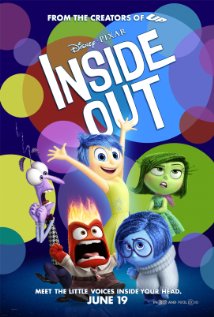Inside “Inside Out” — Takes on Pixar’s Hit Movie About Feelings
Posted on July 6, 2015 at 3:35 pm
“Inside Out” is not just one of the best movies of the year (animated and live action). It is also one of the most psychologically profound and astute films about emotions and the mind ever made. It set the all-time box office opening weekend record for a non-series film and reached number one at the box office this week, out-doing two huge holiday weekend releases, “Terminator Genisys” and “Magic Mike XXL.” 
And it has provoked some exceptionally thoughtful responses from movie critics and specialists in child development. My friend Jen Chaney wrote one for The Dissolve, tying the movie’s themes to other Pixar films that touch on the bittersweetness of the end of childhood, but explaining how this film takes it to a new depth.
According to Inside Out, the middle-school-girl brain is simultaneously orderly yet fragile, crowded with highly charged voices (some previously heard on NBC sitcoms, The Daily Show, and/or Saturday Night Live), and aesthetically similar to a pinball machine, a Lite-Brite, and multiple levels of Candy Crush. It’s rare in a children’s film—or for that matter, any film—to see elements of the human nervous system rendered with such exquisite care and unmitigated glee.
But the film’s point of view is more important than its plot, or its sophisticated view of the machinations behind Riley’s meltdown. For the first time, a Pixar film is confronting how much it hurts when a child realizes her childhood will end—while it’s still ending. It literally gets inside her head, then bluntly announces that being a kid hurts because it doesn’t last. That feels refreshingly candid, even for Pixar.
he movie’s portrayal of sadness successfully dramatizes two central insights from the science of emotion.
First, emotions organize — rather than disrupt — rational thinking. Traditionally, in the history of Western thought, the prevailing view has been that emotions are enemies of rationality and disruptive of cooperative social relations….Second, emotions organize — rather than disrupt — our social lives. Studies have found, for example, that emotions structure (not just color) such disparate social interactions as attachment between parents and children, sibling conflicts, flirtations between young courters and negotiations between rivals.
They would have preferred that Sadness have a less dreary affect. And they note that they recommended many more emotions, but Pixar explained that they could not handle that many characters.
Dan Kois wrote more as a parent than a critic for Slate.
he emotional messages of most entertainment for kids are pretty relentlessly positive: Love your family, stay true to yourself, keep positive, never give in to despair. As the research of Stanford’s Jeanne Tsai has shown, one of the emotions that Americans in particular privilege is joy—excited pleasure. Children see around them, in books and movies and advertisements, exemplars of delight at growing up. “That makes it harder to grapple with sadness,” University of California, Berkeley psychology professor Dacher Keltner told me. “It’s a vacuum in our culture.”
But, points out Keltner, who consulted with Pixar’s Pete Docter on the film, sadness is a powerful tool, a trigger that sends kids back to their parents for comfort and connection. “You gotta hang on to that sadness,” he told me, because in the tumult of early adolescence, it’s the thing that can bring parent and child back together.
Major kudos are due Pixar and Disney for elevating the importance of the emotional lives of children and providing a creative vehicle for helping kids learn to understand and manage their complex emotions. Most importantly, the film reminds parents that having a happy child does not mean your child must always be happy.
Young children are deeply feeling beings. Starting in the earliest months of life, well before they can use words to express themselves, babies have the capacity to experience peaks of joy, excitement, and elation. They also feel fear, grief, sadness, hopelessness, and anger—emotions that many adults understandably find it hard to believe that such young children can experience. But just as Riley in the film needs her parents to hear and empathize with her difficult feelings of pain and loss—which helps her move on in positive ways—so do babies and toddlers.
She concludes with some very practical recommendations for parents.
And be sure to listen to co-writer/director Pete Docter, who spoke about what was behind the film and the crucial moment that changed everything in an interview with “Fresh Air’s” Terry Gross.


